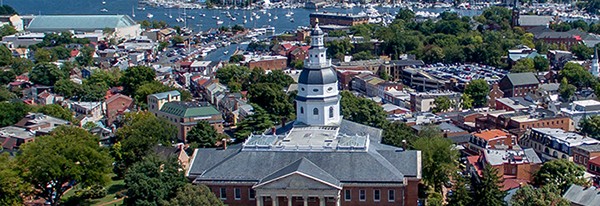Date:
Source: Capital Gazette, Brooks DuBose
This article was originally published in the Capital Gazette on Wednesday, August 11, 2021.
The State of Maryland has transferred the lease for the John Shaw House, the oldest extant building on State Circle, to Historic Annapolis for preservation and restoration.
The Maryland Board of Public Works approved the lease transfer Wednesday for $1 annually. Board members Gov. Larry Hogan, Comptroller Peter Franchot and Treasurer Nancy Kopp all voted in favor of the transfer.
The ornate 1-and-a-half story building at 21 State Circle is named for John Shaw, a cabinetmaker best known for building most of the furniture first used by legislative chambers at the Maryland State House.
The 7,358 square-foot Georgian wood-frame house will be added to about a dozen other properties currently under Historic Annapolis’s master lease, which provides that the properties will be used for general public use and historical preservation purposes. The nonprofit organization is tasked with protecting and preserving historic buildings in the city.
“In the case of John Shaw House, it’s been used with so many different tenants over the years that there’s not much original fabric inside but the outside is entirely original. It’s our responsibility to obviously keep that maintained,” said Robert Clark, Historic Annapolis President and CEO. “Then we will also interpret and use the space properly. … I’m excited about the opportunity.”
Among the buildings the organization currently oversees include the Shiplap House, James Brice House, William Paca House and Gardens, Hogshead, Waterfront Warehouse and the Historic Annapolis Museum and others.
haw bought the house at 21 State Circle in 1784 and owned it until his death in 1829. In addition to being a noted furniture maker, Shaw also worked on the Capitol dome and eventually became the caretaker of the State House, according to the Maryland Archives.
The house also goes by the Shaw-Brooksby House in honor of Cornelius Brooksby, a butcher who bought the property in 1720 and built the house over a five-year period until its completion in 1725, according to the Maryland Historical Trust.
Over the decades, several additions were constructed, greatly increasing its size and altering its interior and exterior design. For instance, a “Captain’s Walk” was added in 1745, followed by an addition on the east end in 1784. By 1900, the front porch that spans the side of the house facing State Circle was installed.
The house features marble flooring in the front foyer and basement and two Victorian marble fireplace mantels thought to have been salvaged from the 1860s Governor’s Mansion before it was demolished.
Officials from Historic Annapolis tour the John Shaw House, the oldest extant building on State Circle, which was transferred from the State of Maryland to the Historic Annapolis foundation Tuesday. An elaborate Victorian fireplace mantel is one of two marble fireplace mantels installed in the John Shaw House from the Governor’s mansion. The original portion of the building was built between 1720 and 1725, but it has been altered and expanded over the years.
The Elk’s Club occupied the building in the early 20th century and later housed the offices for the Maryland Historical Trust from 1975 to 1991.
The house has two entrances, one on State Circle and another on Main Street. The rooms just off the Main Street entrance once housed the offices of former Lt. Gov. Anthony Brown. Upstairs rooms held workers for the governor’s IT, finance and legal offices.
Rooms could be subleased in the future, Clark said.
The Maryland State Clearinghouse conducted an intergovernmental review of the project and recommended it to be declared excess to the need of the Department of General Services contingent upon the Maryland Department of The Environment’s qualifying comments and the Maryland Historical Trust’s requirements.
None of the local or state agencies that provide review comments expressed an interest in acquiring the property, according to the clearinghouse.


